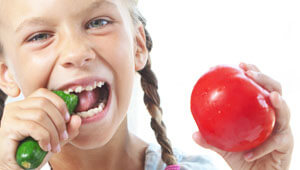Great Foods, Great Kids


“It’s so important to get kids started with good foods early on, because we are molding their taste buds,” says Marilyn Tanner, pediatric dietician at Washington University in St. Louis, Missouri, and spokeswoman for the American Dietetic Association. “The bottom line is exposure. If kids are exposed to a variety of foods and see this as the norm, they will eat them.”
The best way to expand your kids’ food repertoire: Let them see you enjoying nutritious foods. Kids rank parents as their top role models, according to a survey of the ADA. Yet parents don’t always model the best eating habits. Most Americans eat two or three servings of fruits and vegetables a day-well below the five-a-day recommendation.
To get those healthful foods into your family’s diet, have some fun:
- Go to a local food festival and sample different foods together.
- See how many different colors of the rainbow you can include in one meal.
- Choose a country and cook up some of its favorites.
- Pick apples together, then have a taste test to compare varieties.
Try not to label foods as good and bad, Tanner advises. Rather, teach kids there are “everyday foods” needed to fuel the body, grow strong, and look good; and “sometimes foods”-such as ice cream and cookies-to eat occasionally, just for fun.
If your child turns down a new food, don’t give up. Research shows that kids may need to be exposed to a food 15 times before they’ll readily eat it.
As you introduce new foods, be aware of your child’s developmental stage and how that might play into her reaction to them. Chances are, the approach that works for your preschooler is far different from the one that will work for your preteen.
The Smaller the Better
Ages 2 to 5
Preschoolers often don’t like things too hot or too cold, and they can be very sensitive to texture. Celery may feel too stringy, orange juice too pulpy and mashed potatoes too lumpy. New teeth cutting through can make it difficult for them to chew. As you prepare food for your young child, make sure it’s finely chopped.
Young kids’ preferences fluctuate, so keep experimenting. You may need to be creative. For instance, sneak in some fruit by making a happy face on a pancake using blueberries, a cherry, and pineapple chunks.
Most important for this age group: Keep portions small. “You don’t have to overwhelm them, especially when you are trying to get them to taste,” says Tanner. They will be more likely to nibble on a few kernels of corn than dig into a whole bowl. Try one tablespoon of a new food for each year of the child’s life.
Keep The Good Nutrition Coming
Ages 6 to 8
When kids start eating lunch at school, peer pressure enters into their food choices. Be aware of the influence of friends while you continue to offer healthful options at home.
Rather than creating a battle, be casual when you introduce new foods. Mealtime should be a happy, relaxed event. Give your child some choice between one or two new items, such as broccoli or cauliflower. Let them choose how to eat it-raw with a low-fat dip or lightly steamed. Let kids serve up their own sampling sizes. And be sure to offer new foods as part of a meal along with familiar favorites.
Around this age, kids may say, “I don’t like that anymore,” warns Tanner. Ask them what it is they don’t like; you may discover the solution is something as easy as switching from canned to frozen peas because frozen peas are greener and fresher tasting. With vegetables, simpler can be better. Sometimes kids reject them because of a sauce that’s too heavy or spicy. And when you opt to “cheese up” a veggie, keep it healthful with lower-fat cheeses.
And finally, remember that children love attention so be careful not to reinforce your child’s negative eating habits. If a child hears you say, “He’s my picky eater,” it gives him a label to live up to, says Tanner.
Expanding Interests
Ages 9 to 12
At this age, kids are growing rapidly and their caloric needs are increasing. If they are craving the foods they need-ones rich in vitamins and minerals-you’re in luck! Make sure they’re eating well by offering a variety of nutritious foods at every meal.
Older kids are also becoming independent thinkers. They may be more adventurous about trying new foods. Leverage their independence by offering various healthful snack options-such as hummus and pita bread for sandwiches or various ingredients for fruit smoothies-and letting them choose or prepare the food themselves.
This is also a great time to introduce kids to ethnic foods, such as Indian or Mexican dishes that incorporate different fruits, vegetables, and flavors. Try some fun restaurants or peruse the food stands at a local street market.
And finally, get kids involved in family meals. Take them to the grocery store or market with you, read labels with them, and let them pick fresh seafood, fruits, and veggies. By age 9, kids can read recipes and cook with you, so give them as much supervised responsibility as you can. They may surprise you by becoming not only great, healthy eaters, but also enthusiastic family cooks.


